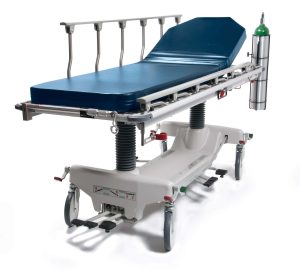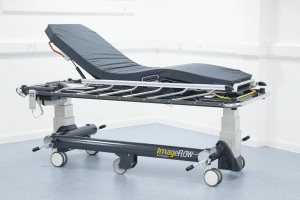Felgains ImageFlow Stretcher vs Hausted Fluoro-Track Fluoroscopy Stretcher – an honest comparison
There are a large number of imaging and fluoroscopy stretchers on the market, each with various positives and drawbacks, and some with special functions, and subsequently, choosing the correct stretcher for your hospital can be a daunting and time-consuming task.
The purpose of this article is to compare two of the most popular stretchers on the market; the Hausted Fluoro-Track Fluoroscopy Stretcher and the Felgains ImageFlow stretcher, covering the key features, positives, and drawbacks of each, to make your decision-making process easier and to enable you to make the best decision for your hospital.
Key features comparison table
|
Hausted Fluoro-Track Stretcher |
Felgains ImageFlow Stretcher | |
| Safe Working Load | 227kg | 320kg |
| Lowest Height (mm) | 584 | 595 |
| Highest Height (mm) | 910 | 995 |
| U-Shaped Base? | No | Yes |
| Sliding Top? | Yes | Yes |
| Retractable 5th Wheel? | No | Yes |
| Folding Side Rails? | Yes | Yes |
What is the Hausted Fluoro-Track Fluoroscopy Stretcher?
The Hasuted Fluoro-Track stretcher is designed for use with C–Arms for fluoroscopy-guided procedures, offering the security of a speciality imaging table with the mobility of a stretcher. The unique design, with a sliding top, enables a broader range of imaging capacity without repositioning the patient.
Key Features and Specifications
- Safe working load: 227kg
- Pneumatic backrest
- 200mm castor wheels
- Foot-controlled hydraulics
- Fold-down side rails and push handles
- Radiolucent top
Positives
- Sliding top – The mattress platform slides horizontally, up 152mm and down 304mm, reducing the need to move the patient, trolley base or C arm. As well as increasing efficiency in your imaging department, this reduces the risk of musculoskeletal injury to your staff.
- 5th wheel – The retractable 5th wheel on the Fluoro-Track stretcher makes the stretcher easy and intuitive for staff to move around your hospital, which is especially useful in compact hospital environments such as imaging rooms.
- Foot-controlled hydraulics – Foot-controlled hydraulics enable staff to have their hands free for easily carrying out imaging tasks whilst adjusting the profile and height of the trolley.
- Large 200mm castor wheels – Ensuring easy manoeuvrability for your staff and smooth transport for the patient, even over rough ground or over thresholds.
Drawbacks
- Lack of U-shaped base – Unlike the other stretchers in this list, the Hausted Fluoro-Track doesn’t have a U-shaped base, which means you will be unable to position a C-arm camera as close to the patient, which could lead to difficulty capturing the images you need.
What is the Felgains ImageFlow Stretcher?
The Felgains ImageFlow is a hospital imaging stretcher for Endoscopy, Fluoroscopy and any task requiring the use of a C-arm. The ImageFlow is designed to solve problems with inefficient patient transfer and reduce manual manoeuvring of C-arms and repositioning of patients whilst imaging.
Key Features and Specifications
- Safe working load: 320kg
- Pneumatic backrest and knee-brake
- 150mm double-roller castor wheels
- Sliding radiolucent top
- U-shaped base
- Fold-down side rails
- Retractable 5th wheel
- Stainless steel frame
Positives
- Sliding top – The mattress platform on the ImageFlow slides 490mm horizontally, up and down, greatly reducing the need to move the patient, trolley base or C arm. As well as increasing efficiency in your imaging department, this reduces the risk of musculoskeletal injury to your staff.
- One trolley for multiple tasks – The ImageFlow suits multiple different tasks, including therapeutic Endoscopy, Fluoroscopy and any task requiring the use of a C-arm. It can also be used for patient transfer, right through from your ED department to the imaging department.
- U-shaped base – The U-shaped stretcher base enables you to position a C-arm camera very close to the trolley and offers good clearance for the camera, enabling you to capture clear images exactly where you need to.
- 5th wheel – The retractable 5th wheel on the Fluoro-Track stretcher makes the stretcher easy and intuitive for staff to move around your hospital, which is especially useful in compact hospital environments such as imaging rooms.
- High safe working load – The ImageFlow has an industry-leading safe working load of 320kg SWL, meaning you are able to use it with more patients and also those previously unable to access such treatments due to low safe working loads.
- Robust – Built with a stainless steel frame for longevity and with the hospital environment in mind, the ImageFlow is reliable, robust and always ready to use.
Drawbacks
- Heavy – The robust nature of the ImageFlow means that the stretcher is quite heavy, which may mean some staff find it hard to move around.
Click here to learn more about the ImageFlow stretcher 🡥
Which stretcher should you choose for your hospital?
I trust this article has given you a clear understanding of the two imaging stretchers from Hausted and Felgains, and the positives and drawbacks of each.
Which stretcher you choose for your trust will vary depending on your needs and requirements, and we will happily talk this through with you if required. Often, a hospital would trial a piece of equipment such as a stretcher before purchasing, and we would be happy to arrange this for you.
To get started, feel free to get in touch on 01473 741144, or via the contact form below.
Related articles
How much does the Felgains ImageFlow Stretcher cost?
How to avoid injury when moving and using a C-arm camera for fluoroscopy
What Is The Best Way To Laterally Transfer A Patient In Radiology?
Get in touch
Got a question or want to send us a message? Let’s talk.

